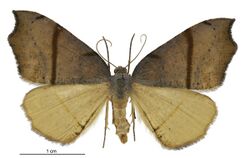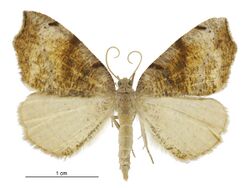Biology:Sestra flexata
| Sestra flexata | |
|---|---|

| |
| Female | |

| |
| Male | |
| Scientific classification | |
| Domain: | Eukaryota |
| Kingdom: | Animalia |
| Phylum: | Arthropoda |
| Class: | Insecta |
| Order: | Lepidoptera |
| Family: | Geometridae |
| Genus: | Sestra |
| Species: | S. flexata
|
| Binomial name | |
| Sestra flexata (Walker, 1862)[1]
| |
| Synonyms[2] | |
| |
Sestra flexata, also known as the common fern looper, is a species of moth in the family Geometridae.[3] This species is endemic to New Zealand.
Taxonomy
S. flexata was first described by Francis Walker in 1862 using specimens collected either in Auckland by D. Bolton.[4] Walker originally named the species Cidaria flexata.[2] George Hudson discussed and illustrated this species in his 1928 book The butterflies and moths of New Zealand.[5] The male holotype is held at the Natural History Museum, London.[2]
Description
The pale yellow egg is cylindrical in shape.[6] The larva of this species is coloured dark brown and is 25 to 30 mm long when mature.[7] The larvae is approximately 1 to 1 1⁄4 inch long and is a brownish greenish colour with yellow tones underneath. Down its back is a brown line with two more lines down its sides. It also has a few black markings and a number of short bristles.[6]
Walker described the adult of this species as follows:
Female. Cinereous fawn-colour, ochraceous beneath. Palpi slender, very short, obliquely ascending. Abdomen yellowish. Forewings acute, subfalcate, with a blackish shade on nearly half the middle space and along the exterior border, which is distinctly angular. Hind wings yellowish, without markings; fore part of the exterior border slightly truncated. Length of the body 6 lines; of the wings 16 lines.[4]
Hudson described the adults of this species as follows:
The expansion of the wings is from 1 1⁄4 to 1 3⁄8 inches. The fore-wings are pale plum-colour; there is an indistinct, curved, brownish transverse line near the base; a straight dark brown line across the middle, and a curved series of brownish dots beyond the middle; the apex is pointed, and the termen has a strong projection a little above the middle. The hind-wings are ochreous, with a series of minute brownish dots across the middle.[5]
Distribution
This species is endemic to New Zealand.[1] This species is found throughout New Zealand including the North, South, Stewart and Chatham Islands.[6]
Host species
The larval hosts of this species are Pteris macilenta and Histiopteris incisa.[7] It has been collected by beating the latter fern.[6]
Behaviour
The older larvae of this species feed at night.[7] When disturbed the larva will drop to the ground.[7] Adults of this species pollinate Leptospermum scoparium.[8] The adult moths are nocturnal, are attracted to light and on the wing from September until March.[7][6]
References
- ↑ 1.0 1.1 "NZOR Name Details - Sestra flexata (Walker, 1862)". https://www.nzor.org.nz/names/b887fe62-0c26-4784-a191-77554ac48260.
- ↑ 2.0 2.1 2.2 , pp. 169, Wikidata Q45083134
- ↑ , pp. 460, Wikidata Q45922947
- ↑ 4.0 4.1 , pp. 1421, Wikidata Q115202878
- ↑ 5.0 5.1 , pp. 146, Wikidata Q58593286
- ↑ 6.0 6.1 6.2 6.3 6.4 , pp. 142-143, Wikidata Q115000559
- ↑ 7.0 7.1 7.2 7.3 7.4 , pp. 19, Wikidata Q115211440
- ↑ , Wikidata Q54669862
Wikidata ☰ Q13557841 entry
 |

